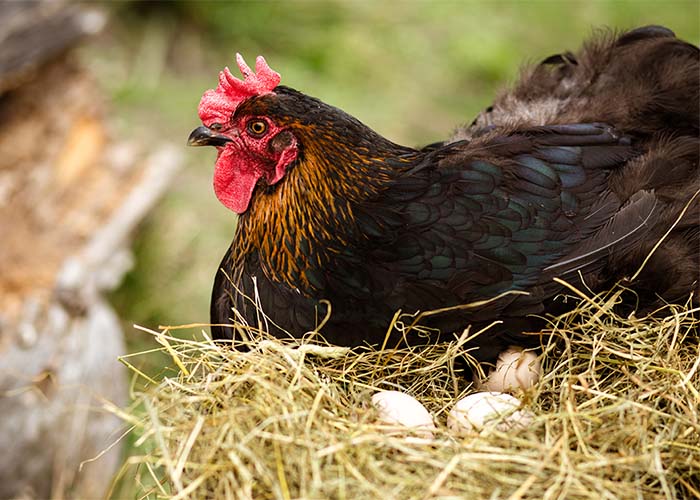
Chick days are here! For chicken enthusiasts, it can be the more exciting season of the year, pouring over order forms and deciding what to add to their flock. However, it can also be a confusing time, with so many breeds and color options available to you. We want to help you welcome those special chicks into your life!
Fresh eggs taste great, they are also better for your health! Many of our customers raise chickens for the birds’ entertaining antics, as well as their delicious eggs. In this blog, we will discuss the various differences between the layer breeds that we offer so that you can make the best selection for your farm.
To learn more about the chicks available in the 2021 season, refer to our Chick Season 2021 page
Amberlink

If you are looking for a solid egg layer, Amberlinks are a great choice. They are high-production, hybrid birds designed and bred for dependable egg-laying. Amberlink hens will lay over 270 eggs per year and will mature to weigh around 4 lb. They are related to ISA Browns and Red Production birds but tend to be harder to find. Amberlinks are stocky and well-balanced birds; they are a bit hardier and larger than ISA Brown chickens, making them great for northern climates. Amberlink chickens tend to be less aggressive than many of the other high production hybrids. They do well in confined situations and are generally mellow in temperament; however, they are also good foragers, so they are also appropriate for a pastured environment.
Ameraucana
Originally developed in the 1970s, the Ameraucana is a highly popular breed, known for their beautifully colored eggs. Derived from Araucana chickens, Ameraucanas were bred to retain the blue-egg laying gene but eliminate some of the health issues associated with the Araucana breed. The original Araucana was a rumpless breed with no tail feathers but those genes led to deaths of incubating chicks so no commercial hatcheries now sell them. In order to address the genetic issues, the Araucana was crossed with other American breeds, hence the new term Ameraucana.
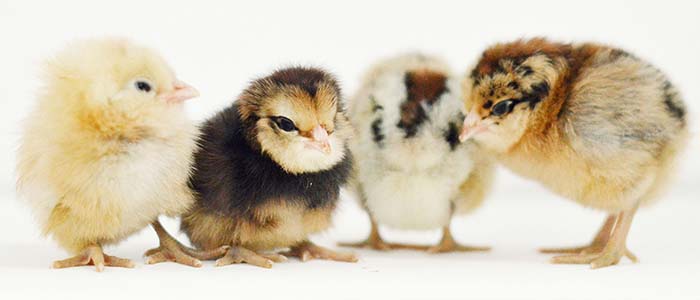
Adults are medium-sized birds with pea combs, muffs and beards and come in a wonderful combination of colors and color patterns, making a beautiful laying flock. Baby chicks come in all colors, just like the adults. Hens will mature around 4 lb and will lay about 250 blue eggs per year. This is a unique, docile, yet extremely hardy breed, that is great fun for the whole family.
Barnevelder
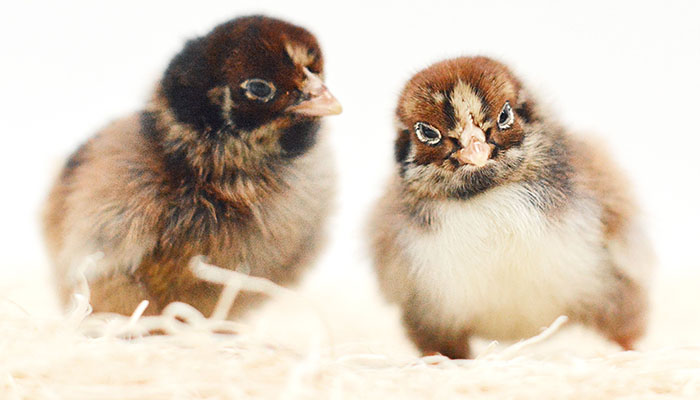
The Barnevelder chicken originates from the Barneveld region of Holland and is sought after for its dark chocolate brown eggs. This beautiful bird with “double laced” feathers is hardy and will lay steadily, even through the winter months (hens will lay about 175-200 eggs per year). They can tolerate a variety of climates and rarely have any health issues. These birds are happy in confinement but also excel at free-ranging and enjoy roaming the property. Barnevelders are very friendly, gentle, talkative, and mild-tempered. These birds are great for a New England family flock!
Barred Cochins, Blue Cochins, and Partridge Cochins

Cochins became famous in the 1800s when members of this Chinese breed were given as a gift to Queen Victoria of England. Cochins are known the world over for being big, friendly, fluffy head to toe feathered chickens. These hens will mature around 8.5 lb, making them a very large chicken. They only lay 180-200 eggs per year, but, unlike many other breeds, prefer to lay in the winter. In general, Cochins are popular due to their sweet personality and fantastic mothering qualities. They will happily sit on any eggs you give them, once they are in the mood. They can even occasionally be used as foster moms for abandoned chicks! Cochins are easily contained because they are poor flyers, however, these poor flight skills can make them prone to attack by predators, so be sure to keep them safe. If you are looking for a hen that is more of a pet, the Cochin may be your ideal bird. They make fabulous pets and lap chickens and are well suited for children, since they are friendly, gentle and extremely mellow, even the roosters.
Barred Rock
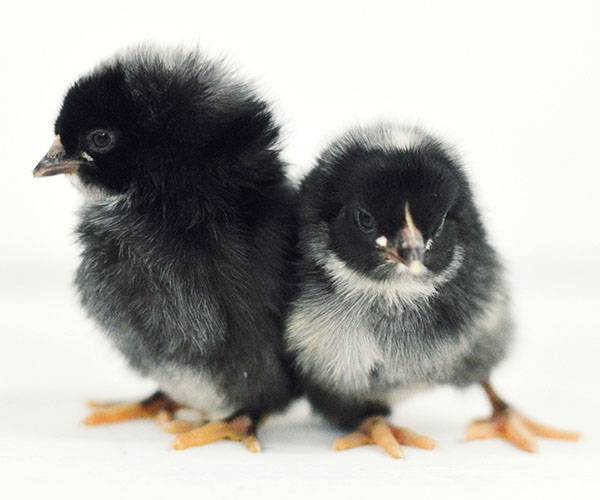
The Barred Rock Chicken is one of the all-time popular favorites in the United States. Developed in New England in the early 1800s, the breed has spread across the country and is an ideal American chicken. Prolific layers of light brown, medium-large eggs, the hens are not discouraged by cold weather. Their bodies are long, broad, and deep with bred-in strength and vitality. These chickens are often called Plymouth Rocks, but this title correctly belongs to the entire breed, not just the Barred variety. Mature hens weigh 7-8 lb and will produce around 280 eggs each year.
Barred Rocks are friendly, sweet, and docile birds, which is partly why they have been a favorite hen for so many years. They suit backyard life well and are easily integrated into a modest family setting. They are inquisitive and love to forage for their food, a skill that they are very adept at.
Australorp
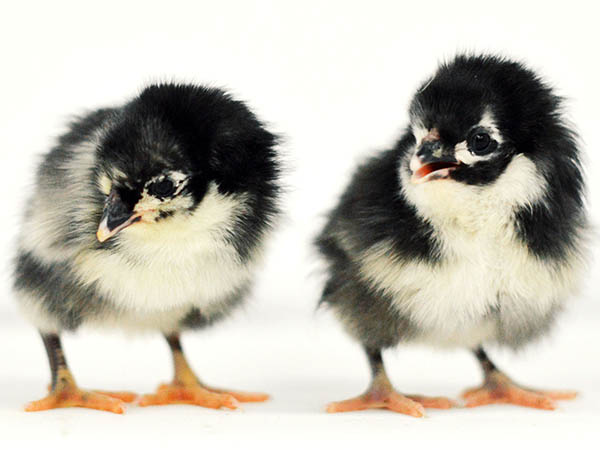
Introduced to the country in the 1920s, Australorps are the Australian version of the Orpington breed. They have become popular and are one of the best layers of light brown eggs. Australorp hens will mature around 6.5-8 lb; generally, they produce over 250 eggs a year. They are calm and friendly and tend to be good mothers. The Australorp’s exceptionally soft, shiny black plumage has hints of green and purple in the sunlight. If you are looking for a robust, healthy hen that is easy to care for, will lay an abundance of eggs, and fit in well with your current flock, the Australorp may be right for you.
Black Sex Links
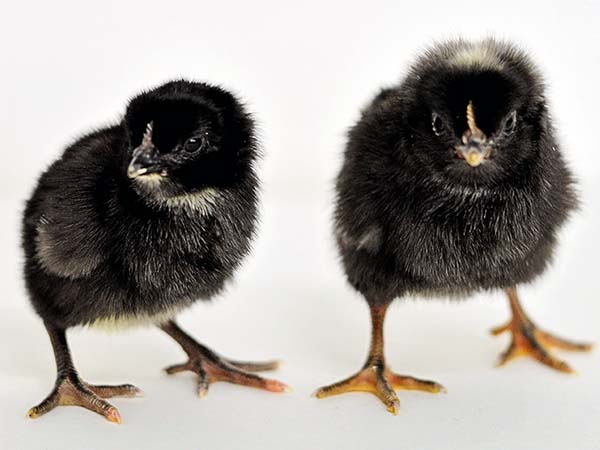
Black Sex Links, also known as Black Stars, are derived from breeding a Rhode Island Red rooster with a Barred Rock Hen. The hens are wonderful layers of large brown eggs, laying about 300 each year. Black Sex Links are easy to raise and have a good feed conversion ratio. As they grow, they will likely develop some patches of reddish feathers, and the black feathering will have a slightly greenish tint or sheen. At maturity, Black Stars weigh a little over 5 lb. They tend to be very hardy and forage well.
Black Minorcas
Initially from Spain, the Minorca chickens are the largest and the heaviest of the Mediterranean breeds. These stunning birds have long and muscular bodies, large combs, long wattles, slate-colored legs, white earlobes, and compact feathering. Because of their tight feathering and large combs, they are prone to frostbite, so they need to be monitored during the winter months.
The hens are fabulous layers, laying large white eggs that are ideal for baking. This beautiful chicken lays some of the largest eggs out of all the standard breeds, laying about 120 each year. Their eggs are one of the largest in the collection basket, and they are classic white in color. However, because of their cold intolerance, they are not strong layers during the winter months. Black Minorcas have a good disposition and are said to have feisty personalities.
Plymouth Blue Rock
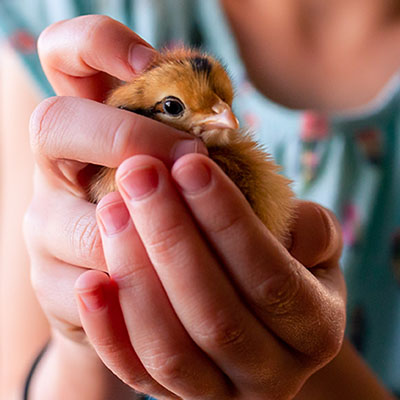
Are you looking for hens with blue-hued plumage and large, medium brown eggs? Then the Plymouth Blue Rock is your chicken. This cross between Plymouth Barred Rocks and the Native Andalusians imported from the Czech Republic allows for smoky blue-grey plumage that can also exhibit barring patterns of darker blue hues. Hens can be expected to produce over 290 large to extra large brown eggs per year. Mature hens will generally weigh about 5-6 lb. They are known to tolerate both the heat and the cold and should continue to lay in cold climates. They are known to be calm, friendly, and curious like their relatives, the Barred Rocks.
Brown Leghorns and White Leghorns

The Leghorn is a favorite of the poultry industry! Leghorns have the typical Mediterranean build – a slim body with large wattles and combs to help them keep cool. The combs can be large and somewhat floppy or they can have a rose comb. The Brown Leghorn probably has the most colorful plumage of the Leghorn family and can roughly be divided into light brown and dark brown. Leghorn hens will mature around 5-6 lb.
Leghorns prefer to not be held or restrained and are rather independent. They are very intelligent and resourceful birds that enjoy foraging and finding their own food. This trait helps to keep the feed bills down. Leghorns do not thrive in a cold environment; they do better in warmer weather. The benefit to having these hens is that Leghorns are historically one of the best laying hens in the world. they can lay over 300 eggs per year. If you want hens that are prolific egg layers, low maintenance, and independent then the Leghorn may be an appropriate selection.
Buckeye
This rare, hard-to-find breed originated in Ohio in the 1890s. These chickens were developed with the severe Ohio winters in mind so this breed does extremely well in cold weather. Their coloring is comparable to the dark mahogany red buckeye nut. The Buckeye is a docile, calm, and friendly bird that is easily handled. Unlike many other breeds, they are seemingly unafraid of humans and will greet you by clustering around your legs.
Buckeyes are very active birds and are great foragers when allowed to roam. They also have a reputation as great mousers. They are said to rival any barn cat! Hens will weigh about 6.5 lb and produce 150-200 eggs per year, laying eggs through the winter. As of 2014, Buckeyes are listed as “Threatened” by the Livestock Breeds Conservancy.
Calico Princess
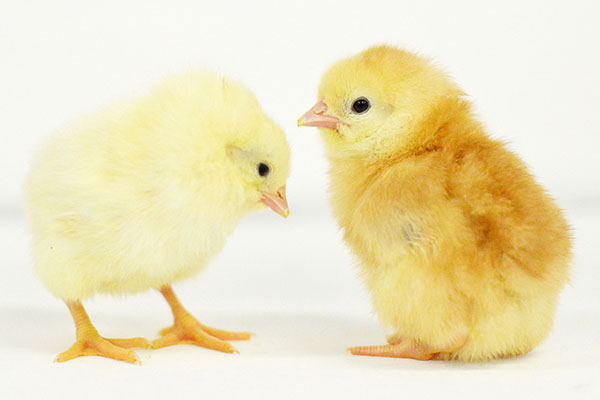
The Calico Princess is a specialty hybrid that was created by a breeder in the Czech Republic. They are topaz colored and their unique feathers alternate in color between the light red-orange and white, which resembles a glimmering topaz stone. Some compare their color to a tortoise-shell calico cat. They are great egg layers and do well in many different environments. They are robust and can adapt well to different climates. They have sweet personalities and are known to be gentle, but also curious and energetic. Calico Princess hens will mature around 5.5 lb and will lay up to 290 large creamy brown eggs per year.
Cream Legbar
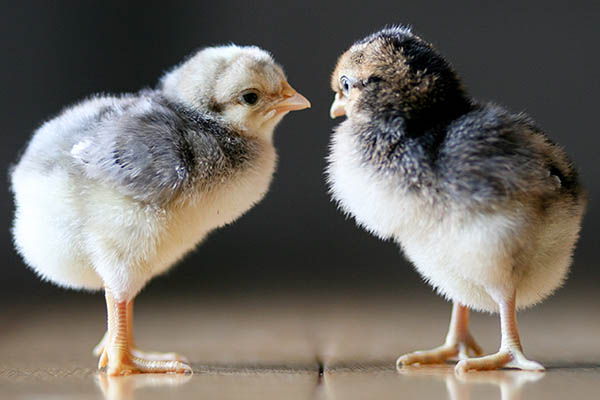
The Cream Legbar, first developed in England in 1931, has become a favorite in the United States. Cream Legbars are very productive layers, averaging around 230 blue eggs per year. They are petite birds with roosters weighing 7.5 lb and hens weighing 6 lb. The coloration of the Cream Legbar is a combination of cream and grays. The barring is most noticeable on the tail and breast of the males; the hen’s barring is much more subtle and she may have some salmon color to her neck and breast.
They are friendly, easily handled and quite sociable. However, they do have a wild side, which is why they do not thrive in confinement. They are excellent foragers, very watchful, and predator savvy. Cream Legbars are a fairly low maintenance bird, so would be ideal for beginners. If you are looking for a chicken that is different, lays blue eggs, and is semi-independent, the Cream Legbars may be right for you.
Cuckoo Marans

Cuckoo Marans were developed in France in the mid-1800s in the town of Marans, France. The breed made their way to England in the early 1900s and quickly became very popular for their rich, dark brown eggs—a trait they are still known for today. The eggs will usually darken as the hens age. Marans lay around 150 eggs each year. They are a historically great dual-purpose bird, prized not only for their dark eggs but for their table qualities as well. Hens mature around 7-8 lb. They are a very hardy bird that is quick to mature. This breed does well in confinement but also loves to forage in a free-range setting. Cuckoo Marans are occasionally broody and will raise their own if allowed to.
Dominique
The Dominique is said to be America’s oldest chicken breed. It was brought to the United States by settlers and helped them to survive the brutal first years of colonization. The name may have come from an early breed of chicken originating in Saint-Domingue (present-day Haiti). Poultry lovers have been working in recent years to increase the numbers of this breed, which had nearly become extinct. They are tolerant of both hot and cold climates, making them an ideal flock addition for all parts of the United States. Their rose comb comes in very handy in cold Northern climates and lessens their chances of frostbite.
Compared to a Barred Rock, the Dominique has a more staggered barring or cuckoo pattern. These hens lay 230-270 medium-sized, light brown eggs per year, which equates to roughly 4 eggs per week. Dominiques are steady and dependable hens that like to forage if allowed to but, will do well in confinement as well. They are described as sweet, gentle, calm, and docile.
Egyptian Fayoumis
These small, active chickens have been raised along the Nile River in Egypt for centuries, and, even though they are quite common there, are practically unknown in this country. No other breed matures quite as quickly and the young pullets are apt to start laying their small, tinted white eggs at 4 to 4.5 months, while the cockerels will start to crow at 5-6 weeks. You can expect about 150 eggs per year.
They are attractively marked with silvery-white hackles and white bars on black background throughout the body plumage. Hens will mature at just 3 lb each. They are very hardy foragers and they are better at flying than most chickens. They are noted for being a predator-resistant chicken to free-range on your farm or acreage. They also do well within a large pen or barn.
Golden Comet

The Hubbard Golden Comet has been widely acclaimed in all areas of the world where brown eggs are preferred. This pullet is easily one of the finest brown egg layers available today. They are cold-hardy, mature very early, and lay eggs of excellent size and quality, producing over 330 eggs per year for about three years. Golden Comets are the result of a cross between a New Hampshire rooster and a White Rock hen. This makes them a sex-link strain, therefore chicks may be sexed by color: the pullets are red and the roosters are white. When mature, the Golden Comet hen is golden red in color, but has some white showing through in her neck and back and weighs about 4 lb.
They easily become family pets as they are so friendly and gentle. In a flock situation, they are peaceful members. The Golden Comet is described as a personable and curious hen, is very mellow, and doesn’t mind being picked up by folks. In fact, some people say this breed actually seeks out people over its own flock mates. If you want hens that will produce an abundance of eggs for your family, look no further than the Golden Comet.
Lakenvelder
Also known as “Shadow on a Sheet,” Lakenvelder chickens are as beautiful as they are useful. The history of Lakenvelder chickens is a bit cloudy but reveals an ancient lineage. The breed seems to have been developed in the area of southern Holland and just over the border in Germany as early as 1727. The breed arrived in America in about 1900. Lakenvelder chickens are noted for egg production, their porcelain white eggs being quite plentiful and nicely shaped.
You can expect between 130-170 medium-sized eggs a year from each Lakenvelder hen. They are great foragers, very active, and very wary. Their alertness gives them a better chance at avoiding predators, and they possess expert foraging abilities. Lakenvelders have delicious tasting meat, although they are not plentifully fleshed with males weighing 5 lb and females weighing only 4 lb. Silver Lakenvelders are somewhat small, but stand erect and proud. Silver Lakenvelders are shy with humans and not aggressive with other chickens. Many owners report that they can be flighty, but that they bear confinement well.
Midnight Majesty Marans
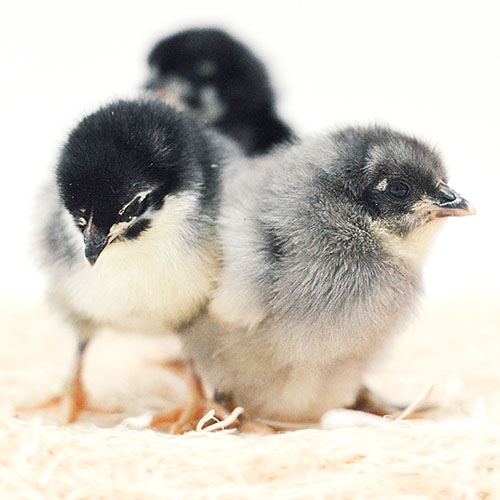
The Midnight Majesty Marans have black plumage and feathered feet. Deep browns show up through their down feathering underneath, making them a mix of beautiful dark brown and black plumage. This breed will lay dark brown eggs and will lay a lot of them! Hens average 250 large dark brown eggs each year and will mature around 6 lb. They are hardy and will perform well in many different climates. Midnight Majesty Marans are docile around people, but also tend to be quite active. You will truly enjoy this breed in your backyard flock and its dark eggs in your egg carton!
Prairie Bluebell Egger
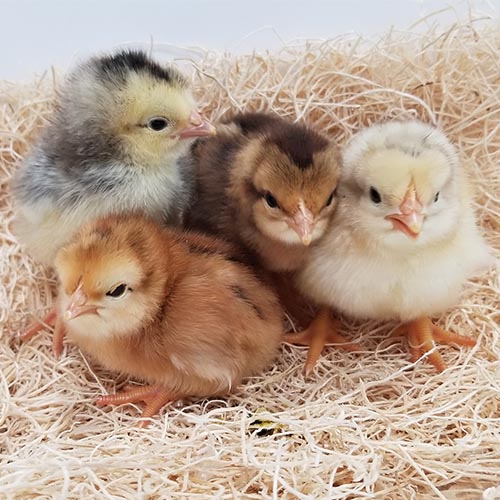
The Prairie Bluebell Egger lays a novel blue egg but produces higher quality eggs than a pure Araucana. This breed was created by crossing an Araucana and White Leghorn, this creates a chicken that lays a large quantity of blue eggs. Hens will weigh around 4 lb and lay about 280 eggs per year. The Prairie Bluebell Egger is an active bird that is very good at foraging. They are lightweight and do not eat as much as larger breeds. They are calm and agreeable birds, which makes them an excellent choice for children. Plumage color varies considerably among individuals, so you can count on having a great variety of beautiful color patterns.
Rhode Island Red

The Rhode Island Red is probably one of the most successful chicken breeds in the world! Developed in the early part of this century in Rhode Island, they have maintained their positive reputation throughout the years. Hens mature at about 6.5 lb and roosters around
8 lb. The Rhode Island Reds are very good at laying eggs; a good hen can lay 200-300 medium to large, light brown eggs each year. Regardless of where you live, these robust birds will take almost any climate in their stride.
Rhode Island Reds are active foragers, scavenging for bugs and seeds, and are not averse to the occasional frog or mouse. They will tolerate confinement, but love to free-range and will often follow you around the yard. They get a good rating as a family-oriented hen and do well around children. A small number of these hens in your backyard will certainly put out a good amount of eggs for the family. If you are undecided what type of chicken will suit you—get Rhode Island Reds.
Rhode Island Blue
Rhode Island Blues are a hybrid crossing two of the best heritage layers: the Rhode Island Red and the Australorp. This cross results in a largely slate blue chicken with a red hackle and saddle feathers. Rhode Island Blues are a medium, production bird—an excellent layer of large brown eggs. Good hens can lay 200-300 eggs each year. These eggs are medium to large, light brown in color, and will increase in size over the years.
Like Rhode Island Reds, they are active foragers, scavenging for bugs and seeds, and love to snack on the occasional frog or small rodent. They will tolerate confinement, but love to free-range and will often follow you around the yard. They get a good rating as a family-oriented hen and do well around children. A small number of these hens in your backyard will certainly put out plenty of eggs for the family.
Sapphire Olive Egger
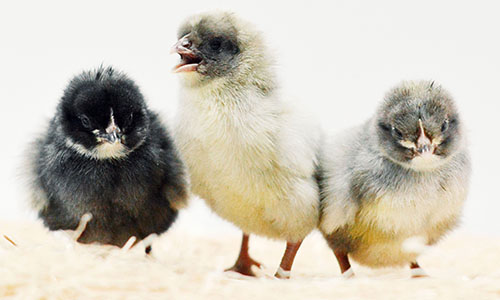
The Sapphire Olive Egger is both easy on the eyes and the olive eggs are sure to be a great addition to your egg carton! This hybrid is a wonderful egg layer and enthusiasts can’t
resist that tuft on their heads. These birds can adapt well to different climates, especially warmer ones. Hens will lay around 240 eggs each year and mature around 6 lb. They are very intelligent and friendly, while still being mellow.
Whiting True Blue
Dr. Tom Whiting, a poultry geneticist specializing in developing feathers for the fly-fishing industry, designed the Whiting True Blue Chicken. With his broad background in poultry genetics, he developed this breed to lay a consistent blue egg. These are not Araucanas, Ameraucanas, or “Easter Eggers,” they are their own breed. The birds will have varying feather patterns and coloration, which will add color and beauty to your flock. They are good layers of bright blue eggs, producing up to 300 eggs each year. Egg size will start out with medium size eggs and progress to larger eggs as hens mature. Hens will weigh around 5.5 lb. Typically, they are friendly and not aggressive toward people or other birds.
Fast Facts
| Breed | Weight | Color of Eggs | Eggs Per Year | Living Conditions |
| Amberlink | 4 lb. | Dark Brown | 270 | Confined Situations and Pastured Environments |
| Ameraucana | 4 lb. | Blue | 250 | Confined Situations, Free Ranging, and Pastured Environments |
| Australorp | 6.5-8 lb. | Light Brown | 250 | Confined Situations and Pastured Environments |
| Barnevelder | 5.5 lb. | Chocolate Brown | 175-200 | Confined Situations, Free Ranging, and Pastured Environments |
| Barred Cochins | 8.5 lb. | Light Brown | 180-200 | Confined Situations and Pastured Environments |
| Barred Rock | 7-8 lb | Light Brown | 280 | Free Ranging and Pastured Environments |
| Black Minorca | 7.5 lb | White | 120 | Free Tanging and Pastured Environments |
| Black Sex Link | 5 lb. | Brown | 300 | Free Ranging and Pastured Environments |
| Blue Cochins | 8.5 lb. | Light Brown | 180-200 | Free Ranging and Pastured Environments |
| Brown Leghorns | 5-6 lb. | White | 300 | Confined Situations, Free Ranging, and Pastured Environments |
| Buckeye | 6.5 lb. | Brown | 150-200 | Confined Situations, Free Ranging, and Pastured Environments |
| Calico Princess | 5.5 lb . | Creamy Brown | 290 | Confined Situations, Free Ranging, and Pastured Environments |
| Cream Legbar | 6 lb. | Blue | 230 | Free Ranging and Pastured Environments |
| Cuckoo Marans | 7-8 lb. | Dark Brown | 150 | Confined Situations, Free Ranging, and Pastured Environments |
| Dominique | 5 lb. | Light Brown | 230-270 | Confined Situations, Free Ranging, and Pastured Environments |
| Egyptian Fayoumis | 3 lb. | Off-White | 150 | Free Ranging and Large Pastures |
| Golden Comet | 4 lb. | Brown | 330 | Confined Situations, Free Ranging, and Pastured Environments |
| Lakenvelder | 4 lb. | Tinted White | 130-170 | Confined Situations and Pastured Environments |
| Midnight Majesty Marans | 6 lb. | Dark Brown | 250 | Confined Situations, Free Ranging, and Pastured Environments |
| Partridge Cochins | 8.5 lb. | Light Brown | 180-200 | Free Ranging and Pastured Environments |
| Plymouth Blue Rock | 5-6 lb. | Brown | 290 | Confined Situations, Free Ranging, and Pastured Environments |
| Prairie Bluebell Egger | 4 lb | Blue | 280 | Free Ranging and Pastured Environments |
| Rhode Island Blue | 6.5 lb. | Light Brown | 200-300 | Confined Situations, Free Ranging, and Pastured Environments |
| Rhode Island Red | 6.5 lb. | Light Brown | 200-300 | Confined Situations, Free Ranging, and Pastured Environments |
| Sapphire Olive Egger | 6 lb. | Olive Green | 240 | Confined Situations and Pastured Environments |
| White Leghorns | 5-6 lb. | White | 300 | Confined Situations, Free Ranging, and Pastured Environments |
| Whiting True Blue | 5.5 lb. | Bright Blue | 300 | Confined Situations and Pastured Environments |
Various breeds of chickens can live together successfully and they often do! This means that you can have a colorful flock and a rainbow of eggs in your egg carton. When raised together from chicks, a natural pecking order will establish itself. For more information about introducing chicks to your flock, we recommend that you read our blog post, Coop Training Your Chickens.
At The Cheshire Horse, we are proud to be your full-service poultry and farm supply store. If you have any questions regarding the various breeds of chicks that we carry, we encourage you to speak with a member of our friendly and knowledgeable sales staff. We would love to help you select the right chicks to join your homestead.
